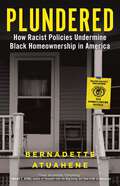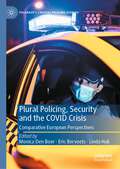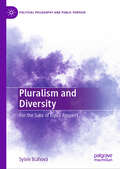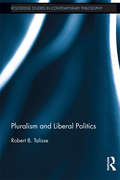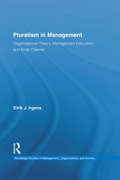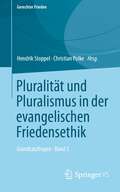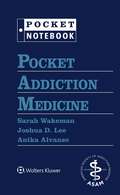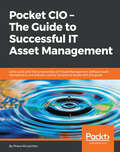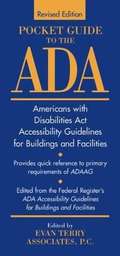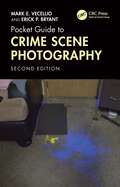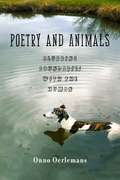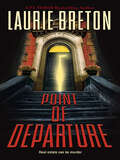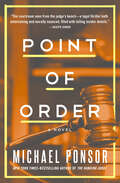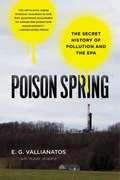- Table View
- List View
Plundered: How Racist Policies Undermine Black Homeownership in America
by Bernadette Atuahene"Clear. Accessible. Compelling." —Ibram X. Kendi, MacArthur Genius fellow and author of Stamped from the Beginning and How to Be an Antiracist In the spirit of Evicted, a property law scholar uses the stories of two grandfathers—one white, one Black—who arrived in Detroit at the turn of the twentieth century to reveal how racist policies weaken Black families, widen the racial wealth gap, and derive profit from pain. When Professor Bernadette Atuahene moved to Detroit, she planned to study the city&’s squatting phenomenon. What she accidentally found was too urgent to ignore. Her neighbors, many of whom had owned their homes for decades, were losing them to property tax foreclosure, leaving once bustling Black neighborhoods blighted with vacant homes. Through years of dogged investigation and research, Atuahene uncovered a system of predatory governance, where public officials raise public dollars through laws and processes that produce or sustain racial inequity—a nationwide practice in no way limited to Detroit. In this powerful work of scholarship and storytelling, Atuahene shows how predatory governance invites complicity from well-meaning people, eviscerates communities, and widens the racial wealth gap. Using a multigenerational narrative, Atuahene tells a riveting tale about racist policies, how they take root, why they flourish, and who profits.
Plunkitt of Tammany Hall: A Series of Very Plain Talks on Very Practical Politics (Dover Thrift Editions)
by William L. RiordonThis classic work presents the candid wit and wisdom of George Washington Plunkitt (1842–1924), a longtime state senator from New York who represented the Fifteenth Assembly District and was especially powerful in New York City. Plunkitt was part of the city's Tammany Hall organization and a cynical practitioner of what today is generally known as "machine politics," a patronage-based system in which politicians openly exercise power for personal gain. Plunkitt defined "dishonest graft" as working solely for one's own interests, as opposed to "honest graft," which involves the interests of one's party and state as well as individual benefits. An enthusiastic party man, he believed in appointments, patronage, spoils, and all the corrupt practices that were curtailed by the civil service law, regarding them as both the rewards and cause of patriotism. Modern readers will find his strikingly modern-sounding motivations and justifications both entertaining and instructive.
Plural Policing, Security and the COVID Crisis: Comparative European Perspectives (Palgrave's Critical Policing Studies)
by Monica Den Boer Eric Bervoets Linda HakThis book critically examines how countries across Europe have dealt with the COVID crisis from a policing and security perspective. Across the chapters, contributors from different countries examine the data, press coverage, and provide professional observations on how policing, law enforcement, police powers and community relations were managed. They focus on how security and governmental actors often failed to align with the formal scripts that were specifically designed for crisis-management, resulting in the wavering application of professional discretion and coercive powers. Their different approaches were evident: in some regions police were less dominantly visible compared to other regions, where the police used a top-down visible and repressive stance vis-à-vis public alignment with COVID rules, including the imposition of lockdown and curfews. Some contributors draw on data from the COROPOL (Corona Policing) Monitor which collated data on crime, plural policing and public order in Europe and around the world during the early phases of the COVID crisis. Overall, this book seeks to provide comparative critical insights and commentary as well as a practical and operational understanding of security governance during the COVID-19 crisis and the lessons learned to improve future preparedness.
Pluralism and Diversity: For the Sake of Equal Respect (Political Philosophy and Public Purpose)
by Sylvie BláhováThis book examines what the justification of political power and the character of a liberal political community in the conditions of pluralism should look like, with the aim of equal respect for all. Sylvie Bláhová argues that if those who understand the principle of respect as the basis of political liberalism are to fulfill all the prerequisites of this principle, they must ensure respect within the liberal political community as a whole. The classic interpretation of political liberalism ensures respect during the process of justification of political power, yet many individuals in the liberal political community remain disrespected, mainly due to their group membership. Accordingly, Bláhová looks for a more complex interpretation of the principle of respect within political liberalism, one that ensures respect beyond the justification of political power. The author argues that the way to achieve respect in the liberal political community is to interpret the criterion of reciprocity in a dual way. Specifically, Bláhová claims that respect can be ensured only in conjunction with the principle of civic friendship, which makes respect more comprehensive. This novel interpretation can ensure unity of the liberal political community and make it stable, which is crucial in conditions of pluralism.
Pluralism and Liberal Neutrality
by RICHARD BELLAMY; MARTIN HOLLISThe crisis of liberalism is in its claim to endorse neutral procedures that allow individuals and groups to pursue their own good, when the very possibility of such neutrality is affected by the growth of plural societies, and resulting divisions of loyalty. This collection explores this crisis.
Pluralism and Liberal Politics (Routledge Studies in Contemporary Philosophy)
by Robert TalisseIn this book, Robert Talisse critically examines the moral and political implications of pluralism, the view that our best moral thinking is indeterminate and that moral conflict is an inescapable feature of the human condition. Through a careful engagement with the work of William James, Isaiah Berlin, John Rawls, and their contemporary followers, Talisse distinguishes two broad types of moral pluralism: metaphysical and epistemic. After arguing that metaphysical pluralism does not offer a compelling account of value and thus cannot ground a viable conception of liberal politics, Talisse proposes and defends a distinctive variety of epistemic pluralism. According to this view, certain value conflicts are at present undecidable rather than intrinsic. Consequently, epistemic pluralism countenances the possibility that further argumentation, enhanced reflection, or the acquisition of more information could yield rational resolutions to the kinds of value conflicts that metaphysical pluralists deem irresolvable as such. Talisse’s epistemic pluralism hence prescribes a politics in which deep value conflicts are to be addressed by ongoing argumentation and free engagement among citizens; the epistemic pluralist thus sees liberal democracy is the proper political response to ongoing moral disagreement.
Pluralism in Management: Organizational Theory, Management Education, and Ernst Cassirer (Routledge Studies in Management, Organizations and Society)
by Eirik IrgensAnalytic philosophy has come to dominate organizational theory and management education, despite criticism from several notable scholars. The European continental philosophical tradition, on the other hand, is seen by some as a counterpoint to US- and UK-dominated functionalistic organizational theories. These two very different schools of thought are now largely practiced in isolation from one another. Late nineteenth and early twentieth century philosopher Ernst Cassirer served as a mediating force and facilitated a fruitful dialogue between the two schools until he was forced to leave Germany when the Nazi party came to power. In Pluralism in Management, author Eirik J. Irgens utilizes Ernst Cassirer’s pluralistic philosophy in order to investigate how different but connected forms of knowing, including art, myth, religion, science, and history may help us become better organizational scholars and management educators. With a special emphasis on the complementary qualities of art and science, Irgens builds on Cassirer to discuss how art and science represent two different but complementary channels to reality, in contrast with each other but not in conflict or contradiction, and the challenge of developing "two-eyed" managers. Revitalizing Cassirer’s almost forgotten philosophy, the book illustrates the value of philosophical application to organizational study, and the need for bringing together the best of the humanities and the science based management traditions in order to improve management education.
Pluralist Politics, Relational Worlds: Vulnerability and Care of the Earth
by Didier ZúñigaIn Pluralist Politics, Relational Worlds, Didier Zúñiga examines the possibility for dialogue and mutual understanding in human and more-than-human worlds. The book responds to the need to find more democratic ways of listening to, giving voice to, and caring for the variety of beings that inhabit the earth. Drawing on ecology and sustainability in democratic theory, Zúñiga demonstrates the transformative potential of a relational ethics that is not only concerned with human animals, but also with the multiplicity of beings on earth, and the relationships in which they are enmeshed. The book offers ways of cultivating and fostering the kinds of relations that are needed to maintain human and more-than-human diversity in order for life to persist. It also calls attention to the quality of the relationships that are needed for life to flourish, advancing our understanding of the diversity of pluralism. Pluralist Politics, Relational Worlds ultimately presses us to question our own condition of human animality so that we may reconsider the relations we entertain with one another and with more-than-human forms of life on earth.
Pluralität und Pluralismus in der evangelischen Friedensethik: Grundsatzfragen • Band 5 (Gerechter Frieden)
by Christian Polke Hendrik StoppelDieses Buch thematisiert Pluralität und Pluralismus in der evangelischen Friedensethik. Denn die Kirche kann nur und muss letztendlich im Rahmen des politischen und weltanschaulich-religiösen Pluralismus agieren. Ob sie dabei selbst als eine einheitliche Stimme auftreten soll, ist Gegenstand der Diskussion. Sie selbst ist schließlich intern immer schon plural verfasst, gesellschaftlich aber eben auch die Kirche. Das verschärft die Frage nach der Stimme der Kirche: Geht ihren Äußerungen ein interner Klärungsprozess voraus, der den inneren Pluralismus zu eben jener einen Stimme zusammenführt oder nimmt die Kirche in Form mehrerer einzelner Stimmen am pluralistischen Konzert teil? Diese Fragen beantwortet der Sammelband aus verschiedenen, nicht nur kirchlichen, Perspektiven.
Poached: Inside the Dark World of Wildlife Trafficking (A Merloyd Lawrence Book)
by Rachel Love NuwerAn intrepid investigation of the criminal world of wildlife trafficking--the poachers, the traders, and the customers--and of those fighting against itJournalist Rachel Nuwer plunges the reader into the underground of global wildlife trafficking, a topic she has been investigating for nearly a decade. Our insatiable demand for animals--for jewelry, pets, medicine, meat, trophies, and fur--is driving a worldwide poaching epidemic, threatening the continued existence of countless species. Illegal wildlife trade now ranks among the largest contraband industries in the world, yet compared to drug, arms, or human trafficking, the wildlife crisis has received scant attention and support, leaving it up to passionate individuals fighting on the ground to try to ensure that elephants, tigers, rhinos, and more are still around for future generations.As Reefer Madness (Schlosser) took us into the drug market, or Susan Orlean descended into the swampy obsessions of The Orchid Thief, Nuwer--an award-winning science journalist with a background in ecology--takes readers on a narrative journey to the front lines of the trade: to killing fields in Africa, traditional medicine black markets in China, and wild meat restaurants in Vietnam. Through exhaustive first-hand reporting that took her to ten countries, Nuwer explores the forces currently driving demand for animals and their parts; the toll that demand is extracting on species across the planet; and the conservationists, rangers, and activists who believe it is not too late to stop the impending extinctions. More than a depressing list of statistics, Poached is the story of the people who believe this is a battle that can be won, that our animals are not beyond salvation.
Pocket Addiction Medicine (Pocket Notebook Series)
by Joshua D. Lee Sarah E. Wakeman Anika A.H. AlvanzoA new volume in the bestselling Pocket Notebook series, Pocket Addiction Medicine delivers highly relevant coverage of this widespread and increasing health care problem in an easily portable source. Edited by physician leaders in Addiction Medicine, Drs. Sarah E. Wakeman, Joshua D. Lee, and Anika Alvanzo and co-published with the American Society of Addiction Medicine (ASAM), this handbook provides must-know information on everything from screening for and diagnosis of substance use disorder to managing intoxication and withdrawal, to ongoing treatment of substance use disorder, including caring for special populations—all designed for quick reference at the point of care. Using the popular, easy-access Pocket Notebook format, it puts key clinical information about a broad range of issues in addiction medicine at your fingertips in seconds.
Pocket Aristotle (Enriched Classics)
by Aristotle Justin KaplanIn this volume of selections from Aristotle, Justin D. Kaplan has included the most widely read, studied, and quoted works of the great philosopher. The editor's notes give the reader a convenient and concise review of each work.
Pocket CIO – The Guide to Successful IT Asset Management: Get to grips with the fundamentals of IT Asset Management, Software Asset Management, and Software License Compliance Audits with this guide
by Phara McLachlanCreate and manage a clear working IT asset management strategy with this unique guideKey FeaturesA detailed IT Asset Management (ITAM) guidebook with real-world templates that can be converted into working ITAM documentsIncludes in-depth discussion on how risk management has changed and the possible solutions needed to address the new normalA step-by-step ITAM manual for newbies as well as seasoned ITAM veteransBook DescriptionThis book is a detailed IT Asset Management (ITAM) guidebook with real-world templates that can be converted into working ITAM documents. It is a step-by-step IT Asset Management manual for the newbies as well as the seasoned ITAM veterans, providing a unique insight into asset management. It discusses how risk management has changed over time and the possible solutions needed to address the new normal. This book is your perfect guide to create holistic IT Asset Management and Software Asset Management programs that close the risk gaps, increases productivity and results in cost efficiencies. It allows the IT Asset Managers, Software Asset Managers, and/or the full ITAM program team to take a deep dive by using the templates offered in the guidebook. You will be aware of the specific roles and responsibilities for every aspect of IT Asset Management, Software Asset Management, and Software License Compliance Audit Response. By the end of this book, you will be well aware of what IT and Software Asset Management is all about and the different steps, processes, and roles required to truly master it.What you will learnClose the hidden risk gaps created by IT assets (hardware and software)Create and manage a proactive ITAM and SAM program and policyA clear, concise explanation of what IT Asset Management and Software Asset Management is, the benefits, and resultsThe best ways to manage a software audit and how to be prepared for oneConsiderations for selecting the best technology for a specific company including what questions should be asked at the onsetIncreasing ITAM program and project success with change managementWho this book is forThis book is intended for CIOs, VPs and CTOs of mid to large-sized enterprises and organizations. If you are dealing with changes such as mergers, acquisitions, divestitures, new products or services, cyber security, mandated regulations, expansion, and much more, this book will help you too.
Pocket Guide To The ADA: Americans With Disabilities Act Accessibility Guidelines For Buildings And Facilities
by Evan Terry Associates StaffPocket Guide to the Americans with Disabilities Act Accessibility Guidelines for Buildings and Facilities Revised Edition This book is intended to help users understand the facilities requirements of the ADAAG. Incorporating all of the latest guideline amendments within a compact and easy-to-use format that contains no confusing abbreviations, this Revised Edition presents the technical building requirements for accessible elements and spaces in new construction, alterations, and additions. The Guide is augmented with more than 60 illustrations from the Americans with Disabilities Act Accessibility Guidelines, and covers special requirements for businesses, restaurants, medical care facilities, libraries, and much more.
Pocket Guide to Crime Scene Photography
by Mark E. Vecellio Erick P. BryantThis handy pocket guide is an essential field guide to crime scene photography. The authors have used limited technical terms and jargon to distill concepts down to understandable, step-by-step methodologies. The book highlights best practices that apply to most any crime scene but specialized instructions—pertaining to unique evidence and crime scenes that present challenging conditions—are also provided. The book introduces concise, comprehensive checklists for photographing such evidence as tire tracks, dust impressions, fingerprints, luminescence from trace blood search reagents, and more. This convenient reference allows police professionals, investigators, and crime scene analysts and technicians to improve their proficiency to achieve professional, reliable results.
Pocket Guide to Crime Scene Photography
by Mark E. Vecellio Erick P. BryantThere are more than 800,000 sworn law enforcement officers employed within the United States, many of whom are regularly tasked with photographing crime scenes or evidence associated with criminal investigations. Despite this fact, law enforcement personnel—including detectives and crime scene investigators—frequently receive little to no formal training in the art and science of photography, let alone for capturing photographic evidence for forensic casework and future legal proceedings. Unlike other resources on the topic that often contain overly complicated or rife with unnecessary or confusing technical jargon—this edition of Pocket Guide to Crime Scene Photography follows in the tradition of the first. The book is wholly updated, based on best practices and advances in camera technology to provide a practical, streamlined approach guide to the photographic documentation of crime scenes and physical evidence. The coverage includes extensive illustrations with two completely new chapters. The first focuses on specialized instructions for photographing shooting incident scenes, bloodstains, and evidence, made visible through infrared light; the is second dedicated to offering advice for photographing crime scenes and evidence with mobile device cameras.Chapters distill the technical jargon and complex processes of photographing crime scenes and evidence into straightforward step-by-step descriptions. Pocket Guide to Crime Scene Photography, Second Edition has been designed in a smaller, handy trim size as a convenient, portable tool to help busy professionals. Its techniques include practical guidelines that can be immediately implemented by law enforcement personnel to maximize their time and improve their skills.Features: Provides an up-to-date, portable reference ideal for use in the field; includes full-color photographs throughout to illustrate key concepts Details how to document various types of evidence, and crime scenes, using both standard and specialized techniques Outlines visualization and photography of evidence—illuminated with alternative light sources—including visible wavelengths, UV, and infrared Presents guidance for personnel who might only be able to use cell phone cameras for photographing evidence and scenes Written by two experienced professionals who know the investigative and courtroom requirements for quality admissible photos.
Poder, derecho y clases sociales
by Pierre BourdieuEste libro constituye una ocasión importante para reconstruir algunas de las claves básicas de la sociología de Bourdieu. Es parte necesaria de toda una obra dedicada a desvelar lo que el sentido común calla u oculta , a dar razón del orden social que se esconde tras el orden simbólico, a descubrir las diferentes formas de dominación de ese orden (incluida la jurídica). Para ello, Bourdieu ha ido elaborando un trabajo científico que, para romper con las premoniciones y los prejuicios de la visión dominante, debe construir sus propios instrumentos de análisis de la realidad social.
Poetic Ethics in Proverbs
by Anne W. StewartThe Book of Proverbs' frequent use of binary oppositions - righteous and wicked, wise and foolish - has led many to assume that its vision of the moral world is relatively simplistic. This study demonstrates that Proverbs in fact presents a remarkably sophisticated response to ethical questions of profound concern to the Israelite sages who crafted the book: what motivates human beings? How do they learn? How does the power of desire shape human characters? Anne W. Stewart analyzes Proverbs' multifaceted collection of images and metaphors to reveal their complex understanding of the development of the moral self, which suggests that character formation requires educating all of the senses and not simply the cognitive faculties. One of few works to make explicit connections between the poetic form of Proverbs and its pedagogical function, Poetic Ethics in Proverbs will appeal to all those interested in literary approaches to the Bible.
Poetry and Animals: Blurring the Boundaries with the Human
by Onno OerlemansWhy do poets write about animals? What can poetry do for animals and what can animals do for poetry? In some cases, poetry inscribes meaning on animals, turning them into symbols or caricatures and bringing them into the confines of human culture. It also reveals and revels in the complexity of animals. Poetry, through its great variety and its inherently experimental nature, has embraced the multifaceted nature of animals to cross, blur, and reimagine the boundaries between human and animal.In Poetry and Animals, Onno Oerlemans explores a broad range of English-language poetry about animals from the Middle Ages to the contemporary world. He presents a taxonomy of kinds of animal poems, breaking down the categories and binary oppositions at the root of human thinking about animals. The book considers several different types of poetry: allegorical poems, poems about “the animal” broadly conceived, poems about species of animal, poems about individual animals or the animal as individual, and poems about hybrids and hybridity. Through careful readings of dozens of poems that reveal generous and often sympathetic approaches to recognizing and valuing animals’ difference and similarity, Oerlemans demonstrates how the forms and modes of poetry can sensitize us to the moral standing of animals and give us new ways to think through the problems of the human-animal divide.
Point Made: How to Write Like the Nation’s Top Advocates
by Ross Guberman<p>With Point Made, legal writing expert, Ross Guberman, throws a life preserver to attorneys, who are under more pressure than ever to produce compelling prose. What is the strongest opening for a motion or brief? How to draft winning headings? How to tell a persuasive story when the record is dry and dense? The answers are "more science than art," says Guberman, who has analyzed stellar arguments by distinguished attorneys to develop step-by-step instructions for achieving the results you want. <p>The author takes an empirical approach, drawing heavily on the writings of the nation's 50 most influential lawyers, including Barack Obama, John Roberts, Elena Kagan, Ted Olson, and David Boies. Their strategies, demystified and broken down into specific, learnable techniques, become a detailed writing guide full of practical models. In FCC v. Fox, for example, Kathleen Sullivan conjures the potentially dangerous, unintended consequences of finding for the other side (the "Why Should I Care?" technique). Arguing against allowing the FCC to continue fining broadcasters that let the "F-word" slip out, she highlights the chilling effect these fines have on America's radio and TV stations, "discouraging live programming altogether, with attendant loss to valuable and vibrant programming that has long been part of American culture." <p>Each chapter of Point Made focuses on a typically tough challenge, providing a strategic roadmap and practical tips along with annotated examples of how prominent attorneys have resolved that challenge in varied trial and appellate briefs. Short examples and explanations with engaging titles--"Brass Tacks," "Talk to Yourself," "Russian Doll"--deliver weighty materials with a light tone, making the guidelines easy to remember and apply. <p>In addition to all-new examples from the original 50 advocates, this Second Edition introduces eight new superstar lawyers from Solicitor General Don Verrilli, Deanne Maynard, Larry Robbins, and Lisa Blatt to Joshua Rosencranz, Texas Senator Ted Cruz, Judy Clarke, and Sri Srinvasan, now a D.C. Circuit Judge. Ross Guberman also provides provocative new examples from the Affordable Care Act wars, the same-sex marriage fight, and many other recent high-profile cases. Considerably more commentary on the examples is included, along with dozens of style and grammar tips interspersed throughout. Also, for those who seek to improve their advocacy skills and for those who simply need a step-by-step guide to making a good brief better, the book concludes with an all-new set of 50 writing challenges corresponding to the 50 techniques.</p>
Point of Departure
by Laurie BretonEveryone assumes that successful Boston Realtor Kaye Winslow has it all. Until the day she goes out to show an expensive new listing and vanishes into thin air, leaving behind her credit cards, her BlackBerry and an unidentified male corpse.None of this makes sense-not to her husband, not to her business partner and not to the Boston P.D. But as the investigation ratchets up, homicide detectives Doug Policzki and Lorna Abrams discover the beautiful blond Realtor has an interesting dark side she’s kept carefully hidden.Turns out a lot of people don’t like Kaye, and many of them have a beef with her. But until the not-so-lovely Kaye Winslow is located, people close to her are just a little bit twitchy-because any one of them could be accused of murder.
Point of Order (The Judge Norcross Novels)
by Michael PonsorIn this explosive legal thriller, Judge David Norcross enters dangerous terrain when a favor to a colleague lands him a fifty-year-old homicide case. The defendant, Dominic O&’Connell—with the help of his gangster uncle—is one of Boston&’s most charming and successful businessmen. His rise from poverty to power is the stuff of local legend. But when a dying hitman fingers O&’Connell for the long-ago, unsolved murder of a city police officer, his life and his fortune are on the block. The prosecutor is seeking a life sentence, and Judge Norcross is the last person O&’Connell wants on the bench. With the trial days away, a deadly bombing in Harvard Yard throws the city into turmoil. The FBI believes that terrorists are behind the carnage, and their suspicions soon fix on a man tied to Norcross&’s past. But was the bombing really a terrorist attack, a reprisal by O&’Connell&’s henchmen, or something else? As the threats to the judge and his family mount up, and the violence increases, lives will depend on getting answers to these questions—and getting them fast. Drawing on decades of experience as a trial judge, New York Times–bestselling author Michael Ponsor crafts a gripping third Judge Norcross novel. The result is another page-turning mystery brimming with intrigue, fear, and courage, set in the real-life world of a federal court. &“The courtroom seen from the judge&’s bench—a legal thriller both entertaining and morally nuanced, filled with telling insider details.&” —Joseph KanonPraise for the Judge Norcross Novels &“A story that grips the reader even as it teaches some fine points of criminal procedure.&” —The Washington Post on The Hanging Judge &“There are plenty of surprises to keep readers turning pages. Ponsor gives readers a unique look into the workings of a courtroom. . . . Ponsor&’s debut would make a great movie.&” —Kirkus Reviews (starred review) on The Hanging Judge &“Ponsor brings his rare combination of experience on the bench and flair for storytelling to a timely topic.&” —Joseph J. Ellis, National Book Award–winning author of The Quartet on The One-Eyed Judge
Poison Candy: The Murderous Madam: Inside Dalia Dippolito's Plot to Kill
by Mark Ebner Elizabeth ParkerIn August 2009, former madam Dalia Dippolito conspired with a hit man to arrange her ex-con husband's murder. Days later, it seemed as if all had gone according to plan. The beautiful, young Dalia came home from her health club to an elaborate crime scene, complete with yellow tape outlining her townhome and police milling about. When Sgt. Frank Ranzie of the Boynton Beach, Florida, police informed her of her husband Michael's apparent murder, the newlywed Dippolito can be seen on surveillance video collapsing into the cop's arms, like any loving wife would—or any wife who was pretending to be loving would. The only thing missing from her performance were actual tears. ... And the only thing missing from the murder scene was an actual murder. Tipped off by one of Dalia's lovers, an undercover detective posing as a hit man met with Dalia to plot her husband's murder while his team planned, then staged the murder scenario—brazenly inviting the reality TV show Cops along for the ride. The Cops video went viral, sparking a media frenzy: twisted tales of illicit drugs, secret boyfriends, sex-for-hire, a cuckolded former con man, and the defense's ludicrous claim that the entire hit had been staged by the intended victim for reality TV fame. In Poison Candy, case prosecutor Elizabeth Parker teams with bestselling crime writer Mark Ebner take you behind and beyond the courtroom scenes with astonishing never-before-revealed facts, whipsaw plot twists, and exclusive photos and details far too lurid for the trial that led to 20 years in state prison for Dalia Dippolito.
Poison Pills: The Untold Story of the Vioxx Drug Scandal
by Tom NesiTo the millions of Americans who suffer from chronic pain and arthritis, Vioxx seemed like a miracle. One of the most widely promoted and prescribed pain medications in the world -- used by more than twenty million people -- it was endorsed by the medical establishment and celebrities such as Olympic champion figure skater Dorothy Hamill. With annual sales of $2.5 billion, Vioxx became a pharmaceutical bonanza before being abruptly taken off the market in September 2004, after it was revealed that it led to an increased risk of heart-related disease and death.Drawing on internal documents, video footage, court testimony, and exclusive interviews, as well as three decades of experience inside the medical industry, Tom Nesi tells the dramatic story of what the drug's manufacturer, Merck, knew and when. It is a compelling narrative of business and medical science run amok, with a cast of characters ranging from those at the highest levels of the multibillion-dollar pharmaceutical industry to research scientists, marketers, and drug company sales reps. Here also are accounts from physicians, lawyers, financial analysts, and patients and their families whose lives have been forever altered by Vioxx.Set against a fascinating history of the origins of the modern pharmaceutical industry, POISON PILLS is a shocking tale that involves the breakdown of the United States medical system, the failures of the Food and Drug Administration, and enormous profits made by a large pharmaceutical corporation at the potential cost of thousands of lives.
Poison Spring: The Secret History of Pollution and the EPA
by Mckay Jenkins E. G. VallianatosWhen you order a meal in a restaurant, you won't find malathion, kelthane or arsenic listed on the menu as an ingredient of your entrée, but these and scores of other pesticides and dangerous chemicals are in the food we eat. They are dumped into the environment where they seep into our water supply and float in the air we breathe. The use of these poisons is approved--or in some cases, simply ignored--by the Environmental Protection Agency. Poison Spring documents, in devastating detail, the EPA's corruption and misuse of science and public trust. In its half-century of existence, the agency has repeatedly reinforced the chemical-industrial complex by endorsing deadly chemicals, botching field investigations, turning a blind eye to toxic disasters, and swallowing the self-serving claims of industry. E. G. Vallianatos, who saw the EPA from the inside for more than two decades with rising dismay, reveals in Poison Spring how the agency has allowed our lands and waters to be poisoned with more toxic chemicals than ever. No one who cares for the natural world, or for the health of future generations, can ignore this powerful exposé.
